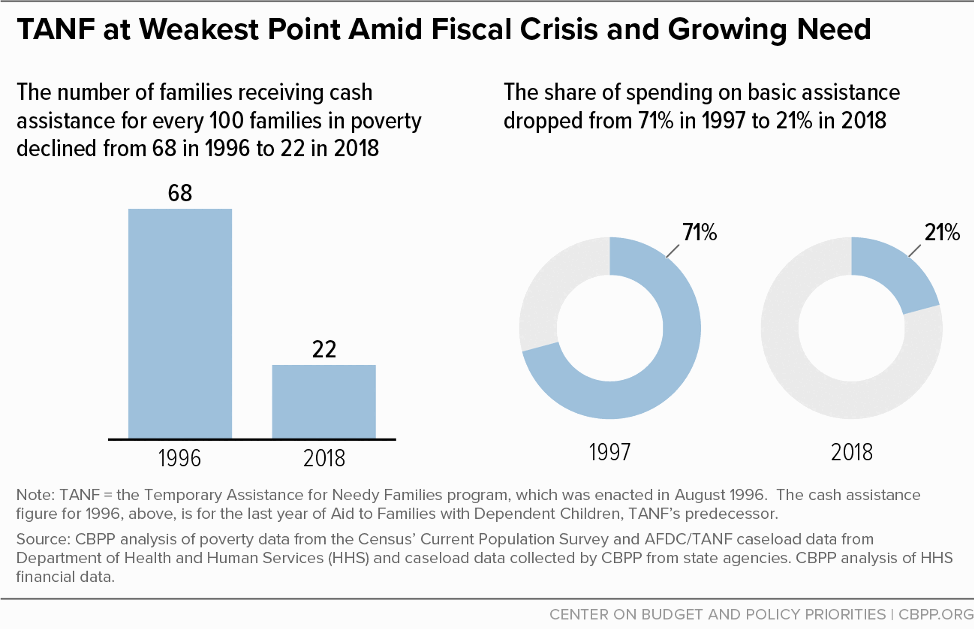BEYOND THE NUMBERS
As states’ revenues plummet and they shift resources to fight the public health crisis, state officials will be looking for ways to fill their budget shortfalls and meet their balanced-budget requirements. In the face of extreme and growing hardship created by the COVID-19 pandemic and deep economic downturn, states shouldn’t use Temporary Assistance for Needy Families (TANF) funds to help balance their budgets as they did during the Great Recession. With TANF applications rising in some states, state and federal policymakers should protect TANF funds to meet the growing need for direct financial assistance, and the next fiscal stimulus package should include additional state fiscal relief to help states avoid making deep budget cuts.
Families in poverty can use the critical cash that TANF provides for food, rent, medicine, hand sanitizer, disinfectant, toilet paper, diapers, and other necessities to keep them safe and healthy during the pandemic.
TANF funds to help families meet such basic needs are inadequate, however. The block grant has lost almost 40 percent of its inflation-adjusted value since its start. In addition, for years states have taken advantage of TANF’s flexible funding to use it in areas outside of basic assistance or direct payments to families.
While the nation was still recovering from the Great Recession, several states in 2012 cut their TANF programs to cover budget shortfalls despite still-high poverty. Today — as we face a far worse economic crisis —TANF is at its weakest point ever. The share of spending on basic assistance dropped from 71 percent in 1997 to 21 percent in 2018. TANF’s reach has also declined; its predecessor, Aid to Families with Dependent Children, served 68 families for every 100 in poverty in 1996, but under TANF that figure dropped to 22 by 2018. (See graphic.) If states cut TANF programs, even fewer families in poverty would have the cash to meet their basic needs.
While federal lawmakers have provided a one-time stimulus payment for families and new expansions of unemployment benefits, these don’t replace the need for TANF cash assistance. Many TANF families won’t be eligible for unemployment benefits, and some may not receive the one-time stimulus payments if they can’t navigate the application process. But many TANF families will face needs that will be long-lasting: the Congressional Budget Office has projected that high levels of unemployment could extend at least through the end of 2021, making it harder for adults receiving TANF to find a job.
States shouldn’t shift TANF’s limited resources to help plug state budget holes, and federal policymakers can take several steps to prevent them from doing so. In the next stimulus package, they should:
- Establish an emergency fund to help state human service agencies meet the overwhelming needs of families and individuals requesting assistance. During the last recession, President Obama and Congress created a highly successful TANF Emergency Fund. The fund provided additional resources for cash assistance as caseloads grew as well as for short-term aid to avert crises and for subsidized jobs. There’s bipartisan support for bolstering TANF, but such a fund should not be exclusive to helping families with children, the group TANF serves. Instead, a new emergency fund should aid a broader group of households and individuals in need.
- Prohibit states from narrowing TANF eligibility and cutting benefits. In exchange for giving states’ human service agencies more money, the federal government should bar them from enacting cash eligibility policies that are more restrictive than those in place when the pandemic started. In fact, the policy should impose financial penalties on states that cut the program. Furthermore, during a time of few available jobs and social distancing measures, few families will be able to meet TANF obligations. Therefore, federal policymakers should also suspend provisions such as work requirements, sanctions on those who don’t meet requirements, and time limits on benefits so families don’t lose critical assistance during the public health and economic crisis.
- Give states additional aid to help them weather their fiscal crises. The most effective strategy for protecting TANF is to make sure that states have other funds to draw upon to provide critical services. While President Trump and Congress have already provided some fiscal relief to states, it will fall far short of what they will need to balance their budgets and maintain vital assistance. Lessons from the last recession show that the federal fiscal relief that Washington provided to states ended prematurely and was insufficient to promote a robust recovery. The next stimulus package should provide states and localities with adequate, long-lasting fiscal support. That should include additional Medicaid funding that rises and falls with economic conditions and remains in place as long as unemployment remains high. That substantial fiscal relief should also come in the form of grants, not loans.

